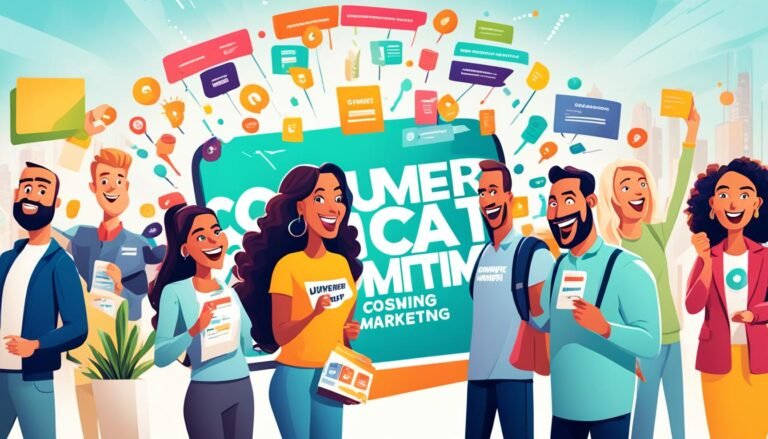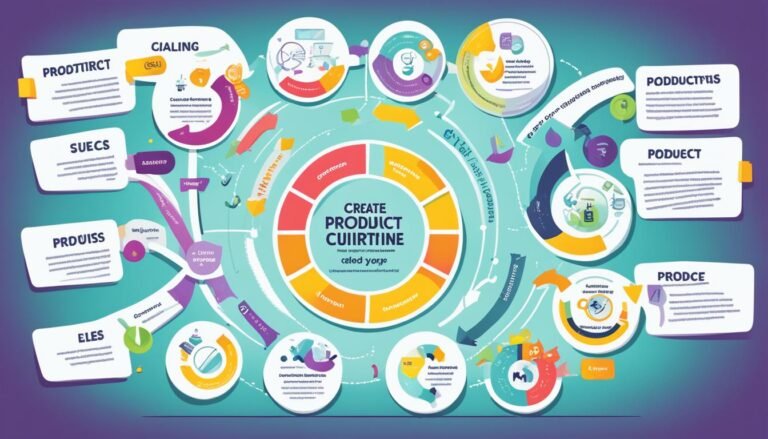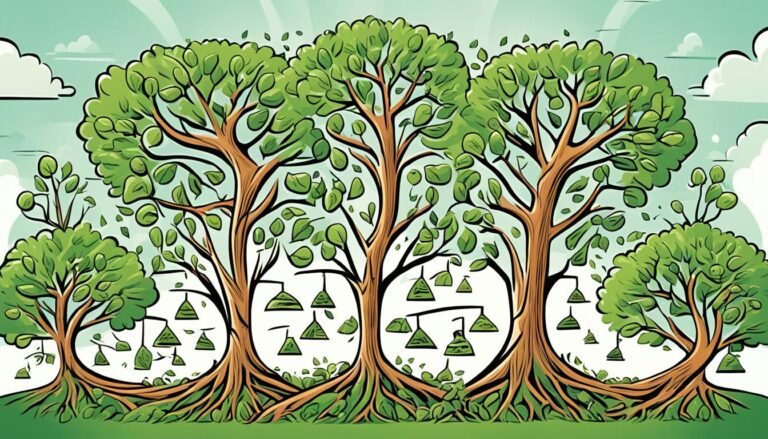Behavioral Marketing Theories: An Overview
Did you know that about 95% of consumers say positive reviews help them make buying choices?
In today’s market, knowing what customers want is key for marketers. Behavioral marketing theories help with this. They guide in making strategies that grab, engage, and turn customers.
These theories, like Maslow’s Hierarchy of Needs and Pavlovian Theory, offer deep insights. They explain what makes customers pick one brand over another. They show how feelings and social and cultural factors influence buying habits.
With this deep knowledge, marketers can make campaigns that really speak to their audience. It’s not just about selling. It’s about building strong relationships and loyalty through emotional and logical connections.
Key Takeaways
- Knowing how consumers behave helps make better marketing campaigns.
- Understanding what drives buying choices is crucial.
- Theories like Maslow’s Hierarchy and Pavlovian Theory are vital.
- Feelings and logic both play big roles in what consumers decide.
- Social and cultural factors shape consumer choices too.
- Good reviews can really affect what people buy.
- A ‘call-to-action’ (CTA) works well to get quick responses from consumers.
Introduction to Behavioral Marketing Theories
Behavioral marketing theories look into what affects consumer choices. They cover everything from key decision factors to cultural impacts. Learning is key to making better decisions, helping us adapt to new things and experiences.
Companies use these theories to make marketing strategies that help influence what people buy. By understanding consumer psychology, marketers can make campaigns that hit the mark with their audience.
What are Behavioral Marketing Theories?
These theories include principles that show how learning and outside factors guide consumer actions. Classical conditioning is one principle that links a stimulus with a certain response. Advertisers use this by pairing products with things like nice music or funny ads to make them more appealing.
Companies also use free samples and test drives to help people learn about their products. These actions, based on behavioral learning theories, change what people like and what they decide to buy.
Importance of Understanding Consumer Behavior
Knowing how consumers behave is key for companies to make their marketing strategies work better. Consumer psychology shows how feelings and views guide buying choices. This helps brands make ads that really connect with people.
According to McKinsey & Company, companies that use consumer behavior data do 85% better in sales growth. Also, 92% of people say having great interactions with a brand is important when deciding what to buy.
By understanding how people make purchase decisions, companies can make their messages more personal. This personal touch builds strong customer relationships and boosts sales. In fact, companies that focus on tailored experiences see 40% more revenue than others.
Consumer Psychology and Its Role in Marketing
Understanding how people think is key in today’s marketing. It helps shape what people decide to buy. By using psychological insights, marketers can make ads that really speak to people. This helps them feel the right emotions, which can change how they act.
The Influence of Emotions on Buying Decisions
Feelings play a big part in what we buy. Research shows feelings often beat logic in making choices. For example, when Apple releases a new iPhone, people get excited. This excitement makes them want to buy the new model, even if their old one still works.
This shows how emotions in marketing can be stronger than facts or logic.
Logical vs Emotional Reasoning in Consumer Behavior
Marketing uses both logic and feelings. Logic is about facts and data. Feelings connect with our deeper needs and feelings. A car ad might talk about safety to use logic. But showing a happy family on a trip uses emotions.
Using both can make ads that really move people. This can change how people decide to buy things.
Consumer psychologists study a variety of topics including how consumers choose businesses, products, and services; the thought processes and emotions behind consumer decisions; and how environmental variables such as friends, family, media, and culture influence buying decisions.
Consumer psychology teaches us about what drives buying habits. It looks at motivations, the environment, and personal likes. Marketers can use this knowledge to make ads that touch both the logical and emotional parts of people. This makes their campaigns more engaging and effective.
Nudge Theory and Choice Architecture
Nudge Theory, made famous by Richard Thaler and Cass Sunstein in 2008, explores how small changes in our environment can change our choices. By using defaults, social proof, and making certain options stand out, marketers can change what we choose without forcing us. This approach is all about making better choices easier.
How Nudge Theory Influences Consumer Choices
Nudge Theory suggests that small, cheap changes can lead to big improvements in behavior. For example, setting default options on websites can boost sign-ups a lot. Personalized nudges, which consider our unique traits, work even better, guiding us towards better choices.
Decision fatigue also plays a role in our choices. After a long day, we might pick fast food over healthier options. In marketing, nudges can help reduce this overload, making customers happier and more likely to buy what we want.
Choice Architecture Strategies in Marketing
Choice architecture is about designing our environments to nudge us towards certain decisions. For example, placing healthy snacks at eye level in cafeterias has made people choose them 20% more often. Framing information positively, like focusing on a medicine’s success rate, can also change how we see things.
Nudging isn’t just for health and education. Governments use it to encourage healthier living and better financial choices. In marketing, small cues can guide us towards choices that benefit both us and businesses.
Persuasive Design in Marketing
Persuasive design uses psychological principles to change how users behave. It aims to boost user engagement and increase conversions in digital marketing. By knowing how users interact with different elements, marketers can make strategies that connect deeply.
Elements of Persuasive Design
Key elements make up a strong persuasive design. The Theory of Planned Behaviour (TBP) shows that Personal Attitude, Subjective Norm, and Perceived Behavioural Control are key. These elements help marketers create experiences that change user behavior for the better.
- Personal Attitude: This is how an individual feels about doing something.
- Subjective Norm: The feeling of social pressure from others to do something.
- Perceived Behavioural Control: How easy or hard someone thinks it is to do something, which affects if they will do it.
Self-Determination Theory (SDT) also points out Autonomy, Competence, and Relatedness as key for well-being and motivation.
Practical Applications in Digital Marketing
Using persuasive design in digital marketing has many practical uses. Web developers are key by making websites easy to use and placing content well to improve user interaction.
Studies show that clear communication helps control how information is given to consumers, affecting their choices. This approach to user engagement is backed by BJ Fogg’s Behavior Model. It highlights the importance of Motivation, Ability, and Trigger in designing behavior.
- Motivation: This includes enjoyment, looking forward to something, and feeling part of a group.
- Ability: This is about how easy or hard a behavior is, considering time, money, effort, and thinking.
- Trigger: The thing that starts the behavior.
Using these parts can greatly improve how consumers react and adopt new things. For example, offering more deals on “thank you” pages can increase conversions by 39% from new visitors.
When done right, these strategies can greatly improve a brand’s digital marketing efforts. They lead to more engagement and higher revenue.
Exploring Cognitive Biases
Marketers need to know about cognitive biases to shape consumer behavior. These biases affect how people see things and how marketing works. By using these biases, marketers can make their strategies better match what consumers want.
Common Cognitive Biases in Consumer Behavior
Many cognitive biases play a big role in how consumers make decisions. Let’s look at some of these biases:
- Attentional Bias: This bias affects what consumers notice. For example, marketing can focus on certain product features that appeal to their audience.
- Choice Supportive Bias: People often stick with their past choices and support those choices more.
- Blind Spot Bias: People often don’t see their own biases but notice them in others, leading to wrong views of consumers.
- The Curse of Knowledge Bias: Marketers with a lot of knowledge might assume everyone knows as much, causing communication problems.
- Dunning Kruger Effect: Thinking one knows more than one actually does can lead to bad decisions and marketing plans.
- Hot Hand Fallacy: Thinking a streak of success will continue can make consumers stick with brands they know.
- Law of the Instrument: Relying too much on familiar tools can limit new ideas.
- Third Person Effect: People think others are more influenced by ads than they are themselves.
- Bandwagon Effect: Following trends makes popular items more appealing.
- Confirmation Bias: Looking for info that backs up what you already believe can greatly influence buying decisions.
- Courtesy Bias: People might not give negative feedback on creative work to be polite.
- Endowment Effect: Owners think their things are worth more than the market price, affecting how they see resale.
- Ikea Effect: People value products they helped make more, which affects DIY and customizable markets.
- Illusion of Control: Overestimating control over outcomes can change how consumers make decisions.
- Hyperbolic Discounting: Immediate rewards are often more appealing than future ones in consumer choices.
- Conservatism Bias: People may not change their beliefs even with new evidence, affecting how they see brands.
- Continued Influence Effect: Wrong information can keep shaping opinions even after it’s proven wrong.
- Framing Effect: How information is presented greatly affects consumer decisions, as many studies show.
- Irrational Escalation Bias: Justifying more spending despite better options being available can happen.
- Mere Exposure Effect: Being familiar with something makes it more liked. For example, seeing ads more often can make consumers like a product more.
- Post-Purchase Rationalization: Justifying a purchase after buying can increase satisfaction and reduce regret.
- Naïve Realism: Thinking one’s view of reality is the only true one can lead to biased views of consumers.
Studies show how cognitive biases, like the framing effect, can greatly change what consumers prefer. For example, in 1981, Amos Tversky and Daniel Kahneman found that 72% preferred a positively framed option. Only 28% chose a riskier option.
Brands like Lysol and Sensodyne use cognitive biases to improve their marketing. Lysol uses the framing effect by saying it kills 99.9% of germs. Sensodyne uses social proof by saying nine out of ten dentists recommend their product.
By understanding and using cognitive biases, brands can make their marketing more effective. This helps capture their audience and change consumer behavior in positive ways.
Heuristics in Consumer Decision-Making
Heuristics are mental shortcuts that make it easier to choose products or services. They play a big role in how we make decisions. The different types of heuristics and how they are used in marketing can really change how people act.
Types of Heuristics
There are four main types of heuristics that affect how we decide:
- Availability Heuristic: This means we think something is more common if we easily remember it. For example, seeing a product advertised a lot might make us think it’s more popular.
- Representativeness Heuristic: We use this to decide by comparing new things to what we already know. For example, a new smartphone might be judged by how much it’s like Apple, a brand many people trust.
- Anchoring Heuristic: This is when we make decisions based on a first impression, then adjust from there. For instance, seeing a high price on a luxury item can affect what we think is fair later on.
- Attribute Substitution Heuristic: Sometimes, we make decisions by focusing on one easy thing instead of many hard ones. For example, we might look at a brand’s reputation or customer satisfaction rate, like Apple’s 85%, instead of all its features.
Application of Heuristics in Marketing Strategies
Marketers use these heuristics to make their strategies work better:
- Social Proof Marketing: Brands use testimonials and reviews to make their products seem popular and trustworthy, using the availability heuristic.
- Food Tribes: This appeals to specific groups by matching products with their values or certifications, like organic or fair-trade labels.
- Pricing Strategies: Brands set high initial prices to make the discount later seem better, using the anchoring heuristic.
- Brand Loyalty Programs: By focusing on one main benefit of their loyalty programs, marketers can draw in and keep customers.
These examples show how heuristics, decision-making, and marketing work together. They help brands influence what consumers choose.
Emotional Drivers in Consumer Behavior
Emotions greatly influence consumer decisions. In fact, emotions are much faster than rational thought, playing a big role in quick choices. The emotional brain processes information way faster than rational thought, making emotions key in marketing.
Studies show emotions are much stronger than reason in making choices, 24:1 to be exact. For instance, ads that touch on emotions can make people three times more likely to buy from TV ads and twice as likely from print ads. This shows how big of a role emotions play in what we buy.
When people feel good about a brand, they stick with it more. A big bank’s new credit card aimed at Millennials boosted usage by 70% and new accounts by 40%. A leading cleaner saw its market share jump after connecting more with customers emotionally.
Brands that connect with customers on an emotional level see big changes. A clothing store focused on emotional connections saw sales grow three times faster. Emotions don’t just affect what we buy but also make us more loyal to brands and build strong customer relationships.
“Angry consumers make more goal-oriented choices, are less likely to delay their purchase, and are less likely to compromise.”
Understanding different emotions and how they affect buying choices is key. During flu season, brands like Campbell’s see a 1.6% sales boost, while unknown brands only get a 0.1% increase. This shows how emotional ties make us prefer brand-name products over generic ones.
Knowing and using emotional drivers is vital for brands wanting to improve their marketing and build strong brand loyalty. By tapping into emotional aspects, companies can create deeper connections with customers and support steady, long-term growth.
The Role of Behavioral Economics
Behavioral Economics connects economic theories with psychological insights. It shows how often irrational patterns in consumer behavior. This knowledge helps marketers understand what drives consumer choices and how to make better strategies.
Understanding Behavioral Economics
Behavioral Economics mixes psychology and economics to study decision-making. Famous economists like Gary Becker and Daniel Kahneman have greatly helped this field. For example, Thaler’s work on nudging shows how small changes can improve decisions.
Key theories include:
- Prospect Theory: Kahneman and Tversky found that people value gains and losses differently, often fearing losses more.
- Bounded Rationality: Simon’s idea is that people make decisions based on what they know and can process.
- Availability Heuristic: Tversky and Kahneman showed that people judge the likelihood of events by what they can easily remember.
Impact on Marketing Strategies
Knowing Behavioral Economics helps make marketing more effective. For example, by understanding the pain of paying, marketers can make buying easier. They can offer payment plans or rewards for using credit cards. Also, knowing what consumers expect helps tailor messages better.
Other key insights are:
- Choice Architecture: Designing choices can change consumer behavior. Using nudges can lead to better outcomes and happier customers.
- Overchoice: Too many options can overwhelm and lead to indecision. Simplifying choices can help improve decision-making and increase sales.
- Mental Accounting: People think about money differently based on where it comes from and what it’s for. Marketers can use this to frame products in a way that fits with consumers’ thoughts.
Implementing Neuromarketing Techniques
Neuromarketing, also known as consumer neuroscience, helps us understand how our brains react to marketing. It combines neuroscience with marketing to find out what consumers really like. This field is getting bigger, with a market size of nearly $3.3 billion in 2023.
What is Neuromarketing?
Neuromarketing looks at how our brains react to ads and marketing. Unlike surveys, which only get feedback from strong opinions, neuromarketing tracks reactions over time. This gives us a full picture of how people behave when they see ads.
Neuromarketing Tools and Methods
There are many advanced tools and methods used in neuromarketing:
- Brain Scanning: This uses imaging like functional MRI to see how our brains react emotionally to ads.
- Physiological Tracking: Tools like eye-tracking and skin sensors measure how we feel and what we look at in ads.
Studies over the last five years have proven these tools are valuable for marketers. But, they can be hard to use and cost a lot.
The demand for neuromarketing jobs is growing. This means a bright future for those studying behavioral economics. By using advanced neuromarketing tools, marketers can make their ads more engaging. This makes neuromarketing key to modern marketing research.
Behavioral Marketing Theories: Key Takeaways
Behavioral marketing theories help us understand why we make the choices we do. They show that 95% of consumer decisions come from things we don’t even think about. This makes it key to use behavior analysis in marketing to make campaigns work better.
Behavioral economics is also vital in marketing. It looks at how our minds affect our spending choices. For example, the loss aversion principle says we fear losing more than we value gaining. Marketers use this to make their messages more powerful.
Using social proof is also big, with 81% of consumers trusting companies with good reviews. This helps with getting customers to stick around. Framing, which focuses on certain parts of a product, also affects how we feel and decide.
Campaigns like Budweiser’s Wassup ad show how important it is to connect with people on an emotional level. Guinness’s 1996 UK campaign proved that being real and imperfect can draw people in.
A Harvard study found that people pay more for products they think took more work to make. This ‘Labor Illusion’ idea can make products seem more valuable.
The halo effect makes us see a brand more positively if it has good qualities. Free trials also make us feel like we own something, which can lead to buying it.
Using behavior analysis well is key to building trust and being recognized. Campaigns that use these insights well will connect with people, leading to more engagement and better marketing.
Conclusion
In today’s fast-changing marketing world, using behavioral insights is key to success. By applying behavioral marketing theories, companies can make campaigns that really speak to their audience. This leads to more engagement and higher sales.
Understanding what drives consumers is vital. This is done by combining consumer psychology with marketing plans. It helps predict how people will act, which is key for making a big impact.
The 7Ps marketing mix shows how complex campaigns need to be structured. It includes product, place, price, promotion, physical evidence, people, and processes. Marketers must balance these elements for effective strategies.
During the COVID-19 pandemic, Waze used a SWOT analysis to adapt to new challenges and chances. This shows how important strategic thinking is in marketing.
Models like Maslow’s Hierarchy of Needs help marketers understand what drives customers. This lets them craft messages that hit the mark. Segmenting the market also helps send targeted content to specific groups, boosting engagement and guiding customers from awareness to loyalty.
Using models like Porter’s Five Forces helps brands tackle external threats and chances. This gives them a competitive edge.
Fields like Game Theory and Behavioral Sciences provide a strong base for making persuasive marketing plans. These theories help marketers craft messages that match consumer behaviors and likes. Effective design language also plays a big role in building brand identity and how people see and use products.
By combining these insights, businesses get the tools they need for lasting marketing success in today’s competitive world.
Source Links
- The Science Of Marketing — 5 Ultimate Consumer Behavior Theories For Marketers
- Marketing Theory – an overview
- 10 principles and theories of marketing psychology
- Behavioural Learning Theories
- Behavioral Marketing: What Is It & How Is It Beneficial? [+ Examples]
- Behavioural Learning Theories
- Consumer Psychology and Behavior
- Marketing Psychology: 7 Tactics That Work | Mailchimp
- Nudge theory
- 4.1.2.4 Behavioural Economics – Choice Architecture (AQA)
- The Top 5 Theories You Need to Design Persuasive Experiences
- Persuasion Marketing
- 21 Cognitive Biases that Influence Marketing Tactics
- 11 Cognitive Biases in Marketing to Boost Customer Retention
- How marketers can use cognitive biases to influence customer decisions | MarTech
- Heuristics and Shopper Behavior in Market Research – Part 1
- Heuristics: Reducing Consumer Decision Friction
- Heuristics – The Decision Lab
- The Power of Emotions in Purchasing Behaviour
- The New Science of Customer Emotions
- Take 5: The Surprising Ways Emotions Shape Consumer Behavior
- What Is Behavioral Economics? Theories, Goals, and Applications
- An Introduction to Behavioral Economics
- What is Neuromarketing? Neuromarketing Techniques and Examples | The Chicago School
- Neuromarketing: What You Need to Know
- 9 Eye-Opening Examples Of Behavioural Economics Marketing
- The Behavioral Science to Capture Attention: Marketing Psychology for Ultimate Engagement – Outbrain
- 6 important marketing theories—and how to apply them in social media campaigns
- Game Theory and Behavioral Sciences for Effective Marketing Strategy







